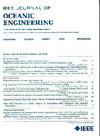Multiheterogeneous AUV Swarm Technology Exemplified by the MAUS Project: Cooperation, Mission Planning and Hybrid Communication
IF 3.8
2区 工程技术
Q1 ENGINEERING, CIVIL
引用次数: 0
Abstract
The mobile autonomous underwater system (MAUS) aims to create next-generation vehicles, focusing on improved intelligence, mission operations, and application scenarios. Accordingly, two types of autonomous underwater vehicles (AUVs) have been developed to operate and collaborate in various applications. The first AUV, named “Hansel,” has hovering capabilities and is tailored to tasks, such as object inspection and detection. The second AUV, called “Gretel,” has going capabilities and is suitable for tasks, such as seafloor mapping. The two AUV types are equipped with different sensors, allowing them to perform distinct tasks simultaneously as a team. The going AUV has a robust navigation system that includes an inertial navigation system, an ultra-short baseline unit, and a Doppler velocity log for dead reckoning. In contrast, the hovering AUV only has a low-cost micro-electro-mechanical system. Gretel's navigation unit improves Hansel's navigation, along with data transfer between the vehicles. The AUVs rely on a hybrid communication system that integrates acoustic, inductive, and optical links to combine the strengths of each technology. To accomplish their individual goals, the AUVs participate in joint mission planning, utilizing a variety of sensors and tasks that are specific to each AUV. This approach is commonly referred to as multiheterogeneous AUV swarm technology. The multiheterogeneous concept developed in the MAUS project was experimentally validated in Kiel Fjord, located in the southwest Baltic Sea, and in La Spezia, Mediterranean Sea.以MAUS项目为例的多异构AUV群技术:合作、任务规划和混合通信
移动自主水下系统(MAUS)旨在创造下一代车辆,专注于改进智能,任务操作和应用场景。因此,两种类型的自主水下航行器(auv)已经被开发出来,在各种应用中进行操作和协作。第一款AUV名为“Hansel”,具有悬停能力,并为物体检查和探测等任务量身定制。第二艘AUV名为“Gretel”,具有航行能力,适合执行海底测绘等任务。这两种类型的AUV配备了不同的传感器,使它们能够作为一个团队同时执行不同的任务。该水下航行器拥有强大的导航系统,包括惯性导航系统、超短基线单元和用于航位推算的多普勒速度日志。相比之下,悬停式AUV只有一个低成本的微机电系统。格蕾特的导航装置改善了汉塞尔的导航,以及车辆之间的数据传输。auv依靠一种混合通信系统,该系统集成了声学、电感和光学链路,以结合每种技术的优势。为了实现各自的目标,AUV参与联合任务规划,利用各种特定于每个AUV的传感器和任务。这种方法通常被称为多异构AUV群技术。MAUS项目中开发的多异质概念在波罗的海西南部的Kiel Fjord和地中海的La Spezia进行了实验验证。
本文章由计算机程序翻译,如有差异,请以英文原文为准。
求助全文
约1分钟内获得全文
求助全文
来源期刊

IEEE Journal of Oceanic Engineering
工程技术-工程:大洋
CiteScore
9.60
自引率
12.20%
发文量
86
审稿时长
12 months
期刊介绍:
The IEEE Journal of Oceanic Engineering (ISSN 0364-9059) is the online-only quarterly publication of the IEEE Oceanic Engineering Society (IEEE OES). The scope of the Journal is the field of interest of the IEEE OES, which encompasses all aspects of science, engineering, and technology that address research, development, and operations pertaining to all bodies of water. This includes the creation of new capabilities and technologies from concept design through prototypes, testing, and operational systems to sense, explore, understand, develop, use, and responsibly manage natural resources.
 求助内容:
求助内容: 应助结果提醒方式:
应助结果提醒方式:


